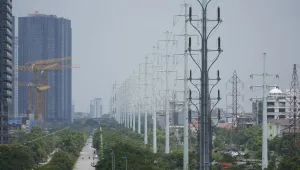
Abstract
New technologies, such as social media and do-it-yourself biotechnology, alter the capacities and incentives of both state and nonstate actors. This can include enabling direct decentralized interventions, in turn altering actors’ power relations. The provision of global public goods, widely regarded as states’ domain, so far has eluded such powerful technological disruptions. We here introduce the idea of highly decentralized solar geoengineering, plausibly done in form of small high-altitude balloons. While solar geoengineering has the potential to greatly reduce climate change, it has generally been conceived as centralized and state deployed. Potential highly decentralized deployment moves the activity from the already contested arena of state action to that of environmentally motivated nongovernmental organizations and individuals, which could disrupt international relations and pose novel challenges for technology and environmental policy. We explore its feasibility, political implications, and governance.
[Our] satellite will collect data about pollution that is warming the planet. We will put that data in the hands of people who can make simple fixes that will change the course of global warming in our lifetime.
—Fred Krupp, President, Environmental Defense Fund [Source]
Introduction
In April 2018, the Environmental Defense Fund (EDF) announced its intention to launch a satellite to monitor the emissions of methane, a potent greenhouse gas whose sources and quantities are not fully understood. While environmental groups have rapidly grown over the years—EDF now has over 700 staff and an annual budget of over $200 million—and have had outsize impact on environmental policies, the announced satellite development adds a new dimension to their work. Philanthropists have a long history of large grants to provide public goods such as libraries, research, and land preservation, especially in the United States (Bremner 1988). However, the direct provision of a global public good—such as launching satellites for scientific monitoring—has traditionally been the responsibility of national governments, usually through cooperation (Kaul, Grunberg, and Stern 1999). Meanwhile, in a world of more multi-billionaires, growing transboundary environmental challenges, and—in some corners—a retreat of the state, such philanthropic actions appear increasingly likely (Giridharadas 2018).
Nonstate provision of global public goods can extend to individuals. The most prominent example for nonstate climate intervention is voluntary greenhouse-gas emissions offsets, with tens of thousands of environmentally motivated individuals spending small sums (~$10-100) in an effort to offset greenhouse-gas emissions and prevent climate change impacts (Bumpus and Liverman 2008). Such action is tightly linked with belief in the importance of climate change (Jacobsen 2011). Meanwhile, offsets’ total impact is limited at best, with a substantial body of literature questioning their effectiveness and the wisdom of encouraging emissions offsets instead of preventing them in the first place (Green 2011).
There might be a more direct way for individuals and other nonstate actors to influence the global environment. Research indicates that solar geoengineering, most prominently in the form of sulfate aerosols deliberately injected into the lower stratosphere, could be effective in reducing climate change, global and rapid in its impacts, technologically feasible, and inexpensive in terms of its direct implementation costs (Keith 2000; Royal Society 2009; National Research Council 2015).[1] This set of characteristics—despite its clear imperfections and controversial nature—has raised the prospect of one or a few actors, possibly even nonstate ones, altering the entire planet’s climate, independent of any consensus among the international community. Solar geoengineering proposals have, until now, relied on centralized deployment systems, such as fleets of specially modified aircraft.
Here we go a step further and introduce a radical, apparently feasible, and politically disruptive way in which solar geoengineering could be implemented. Numerous individuals or other nonstate actors could launch many thousands of unmanned high-altitude balloons in highly distributed yet potentially coordinated fashion. We offer an analytic framework, consider technical and political limitations, discuss nonstate and state actors’ incentives, and explore the implications for political science scholarship and global governance.
Centralized solar geoengineering and nonstate deployment
The basic principle of potentially cooling Earth by deliberately reflecting a small portion of incoming solar radiation has been known for decades. It was the one response mentioned in the first comprehensive government report on anthropogenic climate change (President’s Science Advisory Committee 1965). The possible deployment—and even research—of solar geoengineering, however, has been subject to a decades-long, self-imposed taboo, primarily because it has been seen as a distraction from what is clearly necessary (Lin 2013; G. Wagner and Merk forthcoming) : reducing greenhouse-gas emissions and, ultimately, excess atmospheric greenhouse-gas levels. The publication of a speculative essay by Nobel Laureate Paul Crutzen that highlights the moral quandary of not researching solar geoengineering substantially weakened this taboo (Crutzen 2006). The field has seen a rapid increase in research ever since (Lawrence and Crutzen 2017), with the Intergovernmental Panel on Climate Change recently concluding that stratospheric aerosols could “with high agreement […] limit warming to below 1.5°C” (IPCC 2018, chap. 4, p.56), something no other single intervention could accomplish.
Solar geoengineering’s characteristics, especially the inexpensive nature of an (global) intervention, pose a distinct problem structure. Although solar geoengineering is technically a public good, a single actor’s benefits could be greater than that actor’s direct costs. Thus, in contrast to emissions abatement’s “free rider” problem of suboptimal provision, the main challenge here is that of “free drivers” injecting too much material into the stratosphere too early (G. Wagner and Weitzman 2012; Weitzman 2015; see also: Schelling 1996; Barrett 2008; Victor 2008).
The vast majority of considered solar geoengineering deployment scenarios has focused on state action (Horton and Reynolds 2016; Jinnah and Bushey 2017; Parson 2014). Within this discourse, most attention has been dedicated to problematic unilateral deployment, either by a hegemonic country or a so-called rogue state. Some scholars have discussed possible minilateral implementation (Benedick 2011; Lloyd and Oppenheimer 2014). Others envision global consensus on deployment through, for example, the United Nations General Assembly or a specialized multilateral agreement with widespread participation (Zürn and Schäfer 2013). Consequently, a central question in academic and policy debates has been how to constrain premature and/or unilateral solar geoengineering and to responsibly govern deployment by a larger group of state actors (Pasztor 2017; Stavins and Stowe forthcoming).
However, the present factor limiting solar geoengineering’s consideration and governance is the absence of state action. Besides modest research funding by a handful of states (Necheles, Burns, and Keith 2018), none of whom are (as of yet) meaningfully moving forward with actual policy, research, or development. For one, solar geoengineering might presently seem too hypothetical or uncertain. Second, politicians might be worried about opposition from “deep” green environmentalists, or about fueling international distrust. Third, those most concerned with climate action and, thus, most likely to support solar geoengineering might wish to be seen by others as fully dedicated to emissions abatement and adaptation to a changed climate. Lastly, some leaders might also see no feasible means through which solar geoengineering’s use could be effectively and legitimately governed. Thus, while its problem structure points toward possible premature deployment, solar geoengineering’s present politics indicate suboptimal action (Horton and Reynolds 2016).
Nonstate actors that become concerned about the risk of inadequate progress in solar geoengineering might consider taking action into their own hands. A first step would be funding research. Indeed, a substantial portion of financial support for solar geoengineering research is philanthropic, especially in the United States (Necheles, Burns, and Keith 2018). Centralized nonstate deployment is also possible, at least in principle. Victor (2008) describes how a wealthy “self-appointed protector of the planet,” whom he memorably named “Greenfinger,” after a James Bond villain, might undertake this out of a desire to counter dangerous climate change (p. 324). Although this attention-catching scenario has been invoked to highlight the difficulty of governing solar geoengineering, the few scholars who have considered—albeit briefly—a nonstate deployment scenario usually argue that it seems unlikely. Despite a steady rise of private actors in global environmental governance (Green 2013), states will consider large-scale climatic alterations to be their prerogative, not that of nonstate actors. States in whose territory nonstate actors might deploy centralized solar geoengineering would come under pressure to end the activity. Bodansky (2013), for example, says that a threat of private solar geoengineering would be treated like terrorism and controlled by a combination of police and military action (p. 548). Parson and Ernst (2013) further highlight the fairly high technological requirements of sustained centralized climatic intervention. Meanwhile, while solar geoengineering might be cheap, it is far from costless. A rough calculation of a hypothetical deployment ramp puts the price tag for the first 15 years at over $30 billion, increasing thereafter (Smith and Wagner 2018). That is inexpensive in terms of climate change impacts and of many state budgets, but not in terms of billionaires’ personal wealth (Reynolds, Contreras, and Sarnoff 2017). Ultimately, deployment by a single nonstate actor seems to be an unrealistic scenario, but it is not the only nonstate one.
Highly decentralized nonstate solar geoengineering
Although the literature to date has considered uni- and minilateral state and nonstate as well as multilateral state solar geoengineering deployment, it has neglected the possibility of highly decentralized nonstate deployment. This is an understandable consequence of current conceptualizations of delivery systems, which focus on specialized aircraft, multi-kilometer tethered hoses, rockets, and artillery requiring large capital investments and specialized expertise. There could, however, be significantly more decentralized technologies available, such as, for example, unmanned high-altitude balloons, for which technical and financial barriers to entry have greatly decreased in recent years. Hobbyists have launched balloons, costing ~$25-50, that can carry ~5-10 kilograms (kg) to heights above 20 kilometers (km) (e.g., Ganapati 2010). Similar balloons are readily available online. Their payload could include a few kilograms of sulfur dioxide (SO2), an aerosol precursor, either in a separate delivery device or mixed with the balloon’s lifting gas itself. The balloons themselves could then be designed to ‘fail’ at a specified height.
While there are many possible ways in which such a technology could play out—with balloons only representing perhaps the most obvious currently available technology—any such decentralized implementation would dramatically expand the options available for solar geoengineering deployment. Possible sets of solar geoengineering deployers can now be conceptualized along two dimensions (Table 1).
A single balloon would not alter the global climate. Yet such balloons could be feasibly deployed by thousands or—at least in principle—millions of individuals, likely coordinated by entrepreneurs or campaigners interested in impacting the global climate.
Unmanned high-altitude balloons are a less cost-effective delivery mechanism than the centralized ones. But at ~$5 per kg SO2 delivered, they are only around four times as expensive as a centralized program using high-altitude aircraft (Table 1). Furthermore, highly decentralized solar geoengineering shares the characteristic of its centralized variant, in that it has 2-3 orders of magnitude more impact per dollar than tackling carbon dioxide emissions directly (Keith, Wagner, and Zabel 2017). Cost-effectiveness, of course, is an unlikely primary motivation. Fundamental technical and political feasibility appears much more important.
One advantage might be the deployment system’s resilience. One of the greatest concerns regarding solar geoengineering is that if it were to suddenly and permanently end under conditions of elevated atmospheric greenhouse-gas concentrations, then the previously suppressed climate change would manifest rapidly, and dangerously so (Matthews and Caldeira 2007; Rabitz 2018). More deploying actors and locations would allow it to be more resistant to such rapid possible and sustained termination.
Highly decentralized nonstate solar geoengineering using balloons would face several challenges. Some of these are technical. For example, the amount of helium necessary to lift enough SO2 to lower global average temperatures appreciably would be greater than current world supply. That alone may not be a limiting factor. For one, there is significant potential to expand global helium supply, primarily as byproduct of natural gas extraction. Second, the lifting gas may not need to be helium. Meanwhile, another challenge might be that the balloons themselves could have significant environmental impacts. In addition to technical challenges, the process would need considerable coordination, without which deployment activities would be spatially or temporally poorly distributed, and thus ineffective or counterproductive (Jones et al. 2017). Here, decentralized online platforms could inform actors when, where, and how they should (not) deploy. Distributed ledger technologies (e.g. blockchain) and crowdfunding could help provide an incentive-compatible coordinating mechanism. They could also, if necessary, help evade state control, provide viable funding mechanisms, and enable remote deployment. Indeed, one could think of highly decentralized nonstate solar geoengineering as “crowdsourced,” which, in turn, makes the platform potentially vulnerable to hacking, manipulation, and the projection of power, both nonstate and state.
Incentives and governance implications
At least two challenges to highly decentralized nonstate solar geoengineering are salient to political science scholarship. One regards why a large number of individuals would be motivated to provide a non-excludable global public good. [2] We assert that some people are willing to take actions that are costly in terms of money, time, and effort that (they believe would) support sustainability. This is presently evident in greenhouse-gas emissions offsets (Bumpus and Liverman 2008; Green 2011) and individual donations to environmental causes more broadly (Brulle 2000). There is no ex ante reason why environmentally minded individuals and other nonstate actors would not likewise voluntarily act or pay to contribute to nonstate solar geoengineering (Buck 2012, 266–67). In fact, highly decentralized solar geoengineering might be a more cost-effective and immediate ‘offset’ (Keith, Wagner, and Zabel 2017). Furthermore, highly decentralized solar geoengineering might make inroads among ‘deep’ environmentalists who tend to oppose centralized solar geoengineering interventions (Corner et al. 2013). Much of that opposition might be linked to the high-technology, centralized nature of solar geoengineering as currently imagined. Solar geoengineering in a highly decentralized nonstate form would turn this image on its head and could, thus, appeal to egalitarian-minded environmentalists (Eckersley 1992).
Nevertheless, it remains uncertain whether a large enough number of individuals would be motivated to act. A hundred million balloons launched in a given year, each releasing ~10 kg of SO2 at heights of around 20 km, would lower global average temperature in the subsequent year by ~0.1°C. A smaller number, meanwhile, could serve as a type of civil disobedience in hopes of catalyzing greater state action—or misused by groups seeking to disrupt (climate) policies, with analogies from nuclear to cyber security (Nye 2011).
Numerous motivated disparate individuals could, through highly decentralized solar geoengineering, have impacts on global environmental conditions and on governance in novel ways. International Relations scholarship has increasingly recognized non-state actors’ importance (Josselin and Wallace 2001; Bieler, Higgott, and Underhill 2004), including for global environmental governance (Wapner 1996; Cashore 2002; Andonova, Betsill, and Bulkeley 2009; Green 2013). This work has focused especially on large institutions such as transnational corporations and non-governmental organizations. The former, motivated by private gain, shape international flows of goods, services, capital, and labor. The latter can facilitate the development, adoption, and enforcement of norms and standards. Coupled with large numbers of individuals, non-governmental organizations can coalesce into influential social movements. Radical nonstate actors’ terrorist activities have demonstrably affected international politics, such as through terrorism. Joined by scientists and other experts, they sometimes constitute epistemic communities (Haas 1992). Highly decentralized solar geoengineering, meanwhile, appears to be an unprecedented way in which individuals and other nonstate actors could influence international politics.
The second substantive challenge of interest concerns governance. Decentralization may at once simplify some governance aspects and make oversight and control by states difficult to nearly impossible. In contrast to centralized solar geoengineering, the sources of its decentralized variant would be more difficult to detect and especially to control and prevent. While states could, if they so wished, reduce such activity by regulation (Reynolds 2018). Yet given the globalization of communication and commerce, as well as the small scale of each act, highly decentralized solar geoengineering would be difficult to eradicate altogether. In this way, it would resemble illicit drugs, which states have agreed through international treaties to prohibit. Yet tens of thousands of tons of them are nevertheless produced, internationally transported, and consumed annually. [3]
Perhaps most importantly, states might not be unanimous in their commitment to eradicate highly decentralized solar geoengineering. Even if the international community were to agree in political and legal agreements to do so, some states could hinder or delay domestic enforcement—especially those most vulnerable to climate change impacts and/or resistant to aggressive emissions abatement. Illicit drugs again offer a useful analogy. The large majority of raw substances for cocaine and heroin come from Colombia and Afghanistan, respectively. Their governments’ record in international cooperation to end the production is mixed, at best, which can be explained by the economic benefits and political leverage that it provides. Solar geoengineering, too, might provide both for some states.
Conclusions
Highly decentralized nonstate solar geoengineering is a speculative, suboptimal response to anthropogenic climate change yet appears technologically and economically feasible. Regardless of whether states would condone or condemn it, they would likely find preventing it to be difficult. Highly decentralized direct technological interventions such as this could disrupt state (environmental) policy-making in ways similar to how social media and do-it-yourself [DIY] biotechnology have done. For example, highly decentralized nonstate solar geoengineering could cause states to be even more lax in efforts to reduce greenhouse-gas emissions and adapt to a changed climate, or it could cause them to redouble their efforts in an attempt to undermine such subversive activities. The challenge for policymakers is to channel these bottom-up forces toward providing beneficial global public goods, while minimizing potential downsides.
More broadly, highly decentralized nonstate solar geoengineering would represent two substantial technology-driven shifts in action and, consequently, power. The first of these was intimated in the opening quotes. Technologies are enabling a wider range of actors to directly engage in global environmental protection, including through interventions (Wapner 1996; Green 2013). When states fail to act in ways that nonstate actors desire, the latter can now take direct actions, including launching their own satellite to monitor greenhouse-gas emissions. In the case of solar geoengineering, this type of technological empowerment and subsequent nonstate engagement potentially extends to highly powerful and potentially disruptive direct actions.
Such actions—including the mere threat of action—in turn can force states to respond to individuals and other nonstate actors, including outside a state’s jurisdiction, in new and sometimes surprising ways. At the 1999 World Trade Organization ministerial in Seattle, police were unable to effectively respond to protesters who employed text messages to organize and websites to convey their message globally. In 2013, social media helped catalyze (near-) revolutions in the Arab world (K. M. Wagner and Gainous 2013). Other decentralized technologies posing important challenges extend to everything from DIY biotechnology to 3D-printed guns. There are clearly positive innovations, like direct cash transfer technologies to the global poor such as GiveDirectly, which in turn have important implications to state foreign aid and other policies (Blattman and Niehaus 2014). Yet most technologies have both positive and negative attributes. For example, DIY biotechnology boosters point to potentially important medical breakthroughs by individual innovators in garages. Its detractors point to the potential for bioterrorism. It is of yet unclear where highly decentralized nonstate solar geoengineering would fit into such a spectrum.
Footnotes
[1] Solar geoengineering is variously known as “albedo modification,” “climate engineering,” “solar radiation management,” and “solar radiation modification”—the latter two typically abbreviated as “SRM.”
[2] We mean “good” in the sense of a product that some people desire, not in any normative sense. See Weitzman (2015) on public “gobs” that are normatively neither always good or bad.
[3] https://www.unodc.org/wdr2018/
Bibliography
Andonova, Liliana B., Michele M. Betsill, and Harriet Bulkeley. 2009. “Transnational Climate Governance.” Global Environmental Politics 9 (2): 52–73. https://doi.org/10.1162/glep.2009.9.2.52.
Barrett, Scott. 2008. “The Incredible Economics of Geoengineering.” Environmental and Resource Economics 39 (1): 45–54. https://doi.org/10.1007/s10640-007-9174-8.
Benedick, Richard Elliot. 2011. “Considerations on Governance for Climate Remediation Technologies: Lessons from the ‘Ozone Hole.’” Stanford Journal of Law, Science, and Policy 4: 6.
Bieler, Andreas, Richard Higgott, and Geoffrey Underhill. 2004. Non-State Actors and Authority in the Global System. Routledge.
Blattman, Christopher, and Paul Niehaus. 2014. “Show Them the Money: Why Giving Cash Helps Alleviate Poverty.” Foreign Affairs 93 (3): 117–126.
Bodansky, Daniel. 2013. “The Who, What, and Wherefore of Geoengineering Governance.” Climatic Change 121 (3): 539–551.
Bremner, Robert H. 1988. American Philanthropy. University of Chicago Press.
Brulle, Robert J. 2000. Agency, Democracy, and Nature: The U.S. Environmental Movement from a Critical Theory Perspective. MIT Press.
Buck, Holly Jean. 2012. “Geoengineering: Re-Making Climate for Profit or Humanitarian Intervention?” Development and Change 43 (1): 253–70. https://doi.org/10.1111/j.1467-7660.2011.01744.x.
Bumpus, Adam G., and Diana M. Liverman. 2008. “Accumulation by Decarbonization and the Governance of Carbon Offsets.” Economic Geography 84 (2): 127–155.
Cashore, Benjamin. 2002. “Legitimacy and the Privatization of Environmental Governance: How Non–State Market–Driven (NSMD) Governance Systems Gain Rule–Making Authority.” Governance 15 (4): 503–529.
Corner, Adam, Karen Parkhill, Nick Pidgeon, and Naomi E Vaughan. 2013. “Messing with Nature? Exploring Public Perceptions of Geoengineering in the UK.” Global Environmental Change 23 (5): 938–947.
Crutzen, Paul J. 2006. “Albedo Enhancement by Stratospheric Sulfur Injections: A Contribution to Resolve a Policy Dilemma?” Climatic Change 77 (3): 211–20. https://doi.org/10.1007/s10584-006-9101-y.
Eckersley, Robyn. 1992. Environmentalism and Political Theory: Toward an Ecocentric Approach. Suny Press.
Ganapati, Priya. 2010. “DIY Group Sends $25 Balloon to 70,000 Feet.” Wired, February 12, 2010. https://www.wired.com/2010/02/spacebridge-diy-balloon/.
Giridharadas, Anand. 2018. Winners Take All: The Elite Charade of Changing the World. Knopf Doubleday.
Green, Jessica F. 2011. “Carbon Offsets.” In The Handbook of Innovations in Transnational Governance. Edited by Thomas Hale and David Held. Cambridge, UK: Polity Press.
———. 2013. Rethinking Private Authority: Agents and Entrepreneurs in Global Environmental Governance. Princeton University Press.
Haas, Peter M. 1992. “Introduction: Epistemic Communities and International Policy Coordination.” International Organization 46 (1): 1–35.
Horton, Joshua, and Jesse L. Reynolds. 2016. “The International Politics of Climate Engineering: A Review and Prospectus for International Relations.” The Oxford University Press. http://isr.oxfordjournals.org/content/early/2016/03/17/isr.viv013.
IPCC. 2018. “Global Warming of 1.5°C.” http://www.ipcc.ch/report/sr15/.
Jacobsen, Grant D. 2011. “The Al Gore Effect: An Inconvenient Truth and Voluntary Carbon Offsets.” Journal of Environmental Economics and Management 61 (1): 67–78. https://doi.org/10.1016/j.jeem.2010.08.002.
Jinnah, Sikina, and Douglas Bushey. 2017. “Bringing Politics into SAI.” Ethics & International Affairs 31 (4): 501–6. https://doi.org/10.1017/S089267941700048X.
Jones, Anthony C., James M. Haywood, Nick Dunstone, Kerry Emanuel, Matthew K. Hawcroft, Kevin I. Hodges, and Andy Jones. 2017. “Impacts of Hemispheric Solar Geoengineering on Tropical Cyclone Frequency.” Nature Communications 8 (1). https://doi.org/10.1038/s41467-017-01606-0.
Josselin, Daphne, and William Wallace. 2001. Non-State Actors in World Politics. Springer.
Kaul, Inge, Isabelle Grunberg, and Marc Stern. 1999. Global Public Goods: International Cooperation in the 21st Century. Oxford University Press. http://www.oxfordscholarship.com/view/10.1093/0195130529.001.0001/acprof-9780195130522.
Keith, David W. 2000. “Geoengineering the Climate: History and Prospect.” Annual Review of Energy and the Environment 25 (1): 245–84. https://doi.org/10.1146/annurev.energy.25.1.245.
Keith, David W., Gernot Wagner, and Claire L. Zabel. 2017. “Solar Geoengineering Reduces Atmospheric Carbon Burden.” Nature Climate Change 7 (9): 617.
Lawrence, Mark G., and Paul J. Crutzen. 2017. “Was Breaking the Taboo on Research on Climate Engineering via Albedo Modification a Moral Hazard, or a Moral Imperative?” Earth’s Future 5 (2): 136–43. https://doi.org/10.1002/2016EF000463.
Lin, Albert. 2013. “Does Geoengineering Present a Moral Hazard?” Ecology Law Quarterly 40 (3): 673–712.
Lloyd, Ian D., and Michael Oppenheimer. 2014. “On the Design of an International Governance Framework for Geoengineering.” Global Environmental Politics 14 (2): 45–63. https://doi.org/10.1162/GLEP_a_00228.
Matthews, H. Damon, and Ken Caldeira. 2007. “Transient Climate–Carbon Simulations of Planetary Geoengineering.” Proceedings of the National Academy of Sciences 104 (24): 9949–54. https://doi.org/10.1073/pnas.0700419104.
National Research Council. 2015. Climate Intervention: Reflecting Sunlight to Cool Earth. National Academies Press. http://www.nap.edu/catalog/18988/climate-intervention-reflecting-sunlight-to-cool-earth.
Necheles, Ella, Elizabeth T Burns, and David W. Keith. 2018. “Funding for Solar Geoengineering from 2008 to 2018.” Solar Geoengineering Research Blog (blog). 2018. https://geoengineering.environment.harvard.edu/blog/funding-solar-geoengineering.
Nye, Joseph S. 2011. “Nuclear Lessons for Cyber Security?” Strategic Studies Quarterly 5 (4): 18–38.
Parson, Edward A. 2014. “Climate Engineering in Global Climate Governance: Implications for Participation and Linkage.” Transnational Environmental Law 3 (1): 89–110. https://doi.org/10.1017/S2047102513000496.
Parson, Edward A., and Lia N. Ernst. 2013. “International Governance of Climate Engineering.” Theoretical Inquiries in Law 14 (1): 307–338.
Pasztor, Janos. 2017. “The Need for Governance of Climate Geoengineering.” Ethics & International Affairs 31 (4): 419–430.
President’s Science Advisory Committee. 1965. “Restoring the Quality of Our Environment.”
Rabitz, Florian. 2018. “Governing the Termination Problem in Solar Radiation Management.” Environmental Politics 0 (0): 1–21. https://doi.org/10.1080/09644016.2018.1519879.
Reynolds, Jesse L. 2018. “International Law.” In Climate Engineering and the Law: Regulation and Liability for Solar Radiation Management and Carbon Dioxide Removal, edited by Michael B. Gerrard and Tracy D. Hester:57–153. Cambridge, UK: Cambridge University Press.
Reynolds, Jesse L., Jorge Contreras, and Joshua Sarnoff. 2017. “Solar Climate Engineering and Intellectual Property: Toward a Research Commons.” Minnesota Journal of Law, Science & Technology 18 (1): 1.
Royal Society. 2009. Geoengineering the Climate: Science, Governance and Uncertainty. London: Royal Society. http://royalsociety.org/uploadedFiles/Royal_Society_Content/policy/publications/2009/8693.pdf.
Schelling, Thomas C. 1996. “The Economic Diplomacy of Geoengineering.” Climatic Change 33 (3): 303–7.
Smith, Wake, and Gernot Wagner. 2018. “Stratospheric Aerosol Injection Tactics and Costs in the First 15 Years of Deployment.” Environmental Research Letters.
Stavins, Robert N., and Robert C. Stowe. forthcoming. Governance of the Deployment of Solar Geoengineering. Cambridge, Mass.: Harvard Project on Climate Agreements.
Victor, David G. 2008. “On the Regulation of Geoengineering.” Oxford Review of Economic Policy 24 (2): 322–36. https://doi.org/10.1093/oxrep/grn018.
Wagner, Gernot, and Christine Merk. forthcoming. “The Hazard of Environmental Morality.” Foreign Policy, forthcoming.
Wagner, Gernot, and Martin L. Weitzman. 2012. “Playing God.” Foreign Policy, October 24, 2012. https://foreignpolicy.com/2012/10/24/playing-god/.
Wagner, Kevin M., and Jason Gainous. 2013. “Digital Uprising: The Internet Revolution in the Middle East.” Journal of Information Technology & Politics 10 (3): 261–275.
Wapner, Paul Kevin. 1996. Environmental Activism and World Civic Politics. Suny Press.
Weitzman, Martin L. 2015. “A Voting Architecture for the Governance of Free-Driver Externalities, with Application to Geoengineering.” The Scandinavian Journal of Economics 117 (4): 1049–68. https://doi.org/10.1111/sjoe.12120.
Zürn, Michael, and Stefan Schäfer. 2013. “The Paradox of Climate Engineering.” Global Policy 4 (3): 266–277.
Jesse L. Reynolds is an Emmett/Frankel Fellow in Environmental Law and Policy at University of California, Los Angeles, School of Law, Los Angeles, CA 90095, as well as an associate researcher at the Utrecht Center for Water, Oceans, and Sustainability Law, Utrecht University and a research affiliate at Harvard’s Solar Geoengineering Research Program (reynolds@law.ucla.edu), http://jreynolds.org.
Gernot Wagner is a Research Associate and Lecturer at Harvard University and co-director of Harvard’s Solar Geoengineering Research Program, Cambridge, MA 02138 (gwagner@fas.harvard.edu), https://gwagner.com.
The authors thank David Victor and especially David Keith for helpful early discussions, and Holly Buck, Lizzie Burns, John Dykema, Michael Ford, Peter Irvine, Aseem Mahajan, Juan Moreno-Cruz, Wake Smith, Dustin Tingley, Daniel Zizzamia, and seminar participants at Harvard for thoughtful comments on an earlier draft.
All remaining errors are the authors’ sole responsibility.
Reynolds, Jesse and Gernot Wagner. “Governance of Highly Decentralized Nonstate Actors: the Case of Solar Geoengineering.” November 2018




